Suspended Animation Emergency Backup Column
When he debuted in the syndicated The Huckleberry Hound Show, Huckleberry Hound became an immediate beloved cartoon superstar but just a few years later he had been totally eclipsed by the popularity of his co-star Yogi Bear and relegated in the last decades as a cameo or supporting player in a variety of projects.
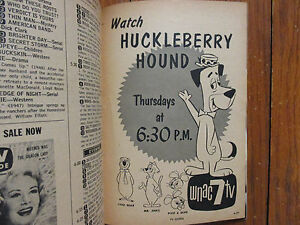 The show opened in syndication during the Fall of 1958 near prime time (6:30pm in New York) appearing on different days in different cities and it lasted until 1961.
The show opened in syndication during the Fall of 1958 near prime time (6:30pm in New York) appearing on different days in different cities and it lasted until 1961.
Huck was one of Hanna-Barbera’s most merchandised stars during his first three years on television. Comics, books, toys, dolls, records, Halloween costumes and more could be found for the blue hound. Due to his association with Kellogg’s he was a regular subject for cereal promotions and giveaways. Huck was featured on the cover of the March 1960 edition of Toys and Novelties magazine.
Laudatory articles on Huck appeared in dozens of magazines (such as TIME and PARENTS) and newspapers (such as The New York Times). It was the first animated show to win an Emmy and it took until 1966 for another animated show to win that award.
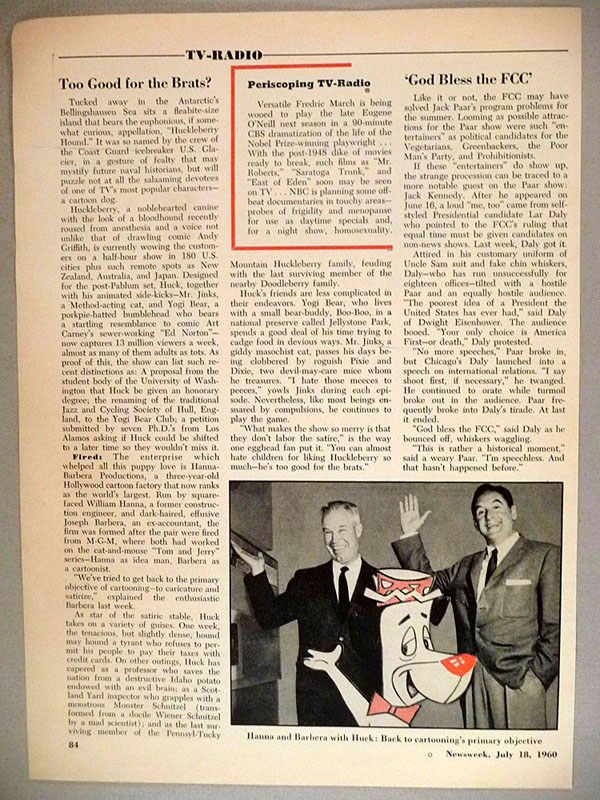
Here is one such of those articles from 1960 – this one from Newsweek
In 1960, the show was seen on 207 television stations across the country, which covered more than 90 per cent of the U.S. population. In 1960, there was a massive “Huck for President” campaign with over five million buttons distributed, a comic book themed to the election, a campaign song, banners and more.
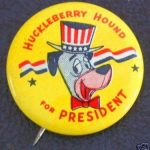 The biggest surprise was the discovery that a large percentage of the 16 million viewers were college students and adults. Producer Bill Hanna felt the puns and witty dialog gave Huck a “sophisticated feel.”
The biggest surprise was the discovery that a large percentage of the 16 million viewers were college students and adults. Producer Bill Hanna felt the puns and witty dialog gave Huck a “sophisticated feel.”
Used to the brash, fast-paced cartoon characters of the past, audiences saw a slow talking, slow moving, blue hound dog who walked on two legs and wore a necktie (to help just the head be animated separate from the body) and an appealing design by Dick Bickenbach who also did the first model sheet for Yogi Bear as well.
More a human in dog’s clothing, Huck’s innate kindness, gentleness and honesty made him a lovable character. However, his amicable demeanor did not mean a dull wit.
“He is a sort of Tennessee-type guy who never gets mad no matter how much he is outraged. He is the fall guy, and a large part of his humor is the way he shrugs off his misfortunes. To Huck, nobody is really bad,” said Warren Foster, Huck’s writer on the early series.
Hearkening back to Mickey Mouse, Huck is really a true cartoon actor. He could be a mailman, a knight in shining armor, a rocket scientist, a sheriff or the heroic Purple Pumpernickel. More than any other of the Hanna-Barbera creations, he is the consummate toon thespian able to play any role with a casual ease and still retain his personality.
“Because of time and budget,” explained long time Hanna- Barbera producer Art Scott, “we couldn’t use a lot of animation. So we borrowed from radio the concept of using a lot of jokes and satire. The characters created were more like stand up comics than slapstick clowns. That’s why the voices were so important.”
“I had been doing the slow-talking, laconic voice for some time at MGM (like Billy Boy),” explained Daws Butler in a 1979 interview. “At one time we were going to do a series with a wolf using the voice. I even used a version of the voice for the big dog in the TV series Hanna-Barbera was already doing.”
One thing that irritated Butler was that some people thought he was imitating comedian Andy Griffith who was doing a similar North Carolina accent. Butler always tried to point out he had been doing the voice for over a decade before people had even heard of Griffith.
“It was the voice that made Huck. Daws had that great voice and it became the character,” said animator and producer Bernie Wolf.
Kellogg’s Cereals, interested for marketing reasons in sponsoring a children’s show, was looking for a suitable animated series. Hanna-Barbera was contacted because it had demonstrated with Ruff and Reddy that they could produce a weekly animated show on a limited budget.
 “Planned animation,” explained Barbera. “Take the Disney method—the old movie method. It tried to mirror life. We don’t. We spoof reality but we don’t mirror it. Our characters don’t walk from a scene, they whiz. Movements that took 24 drawings under the old movie system take us four. We just keep the story moving.” It was estimated that roughly 10,000 drawings total were used for the entire half hour.
“Planned animation,” explained Barbera. “Take the Disney method—the old movie method. It tried to mirror life. We don’t. We spoof reality but we don’t mirror it. Our characters don’t walk from a scene, they whiz. Movements that took 24 drawings under the old movie system take us four. We just keep the story moving.” It was estimated that roughly 10,000 drawings total were used for the entire half hour.
Instead of simply coming up with some live personality to emcee the show like countless other live hosts of children’s shows, Hanna and Barbera envisioned an animated host who would also do the commercials and transitions. They also thought of three separate segments, making it easier to script and leaving some flexibility to change if either the sponsor or audience disliked a particular segment.
Oddly enough, the only thing Kellogg’s didn’t like was Huckleberry Hound’s name. They thought it was too long for children. But it stuck with the word “huckleberry” referring to his blue color.
In the beginning, Joe Barbera was responsible for writing many of the first Huckleberry Hound sequences. By the second season, Warren Foster had taken over as the primary writer.
 Huck joined his other Hanna-Barbera friends as a costume character in a variety of locations. In the early Sixties, he and a costumed Yogi Bear (each costume estimated to cost $700) traveled the country visiting schools and shopping centers.
Huck joined his other Hanna-Barbera friends as a costume character in a variety of locations. In the early Sixties, he and a costumed Yogi Bear (each costume estimated to cost $700) traveled the country visiting schools and shopping centers.
In the Seventies and Eighties, he became associated with several amusement parks including the Taft parks Kings Island, Kings Dominion and Carolwinds. He also appeared at Southern California’s Marineland, Great America in Northern California and Universal Studios Florida.
The United States Coast Guard ice breaker “Glacier,” named a tiny island “Huckleberry Hound” in the Antarctic’s Bellingshausen Sea.
With the cancellation of his syndicated television series, Huck became a supporting player in other Hanna-Barbera projects.
In 1972, Hanna-Barbera released YOGI’S ARK LARK featuring the popular bruin in an air ship setting sail to help the environment. Huck, once the star, was now along just for the ride with such stars as Snagglepuss, Quick Draw McGraw, Peter Potamus and others. The “movie” proved popular enough to become a series in 1973 but YOGI’s ARK only lasted a year.
After this, Huck became one of the regular costars in a line of series that top-lined Yogi or other new stars. These included SCOOBY’S ALL-STAR LAFF-A-LYMPICS (1977). Huck was part of the Yogi Yahooeys team.
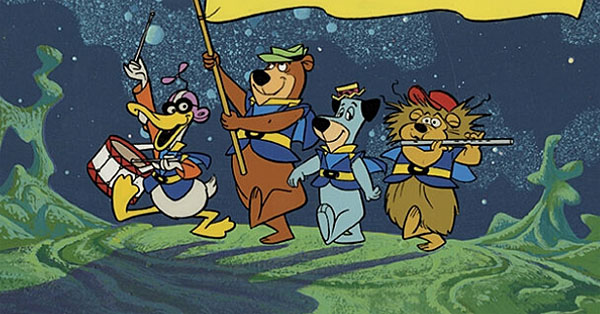
Huck (third from left) was a member of the GALAXY GOOF-UPS
YOGI’S SPACE RACE (1978) featured Huck teamed with the frantic Quack-Up (a Daffy Duck inspired character). The show also had a segment starring THE GALAXY GOOF-UPS. Huck was part of a team, including Yogi, Scare Bear and Quack-Up as a bumbling squad of space policemen.
YOGI’S FIRST CHRISTMAS (1981) was the first of several made for TV features that had Huck as supporting player. The holidays brought another reunion with the half hour YOGI BEAR’S ALL STAR COMEDY CHRISTMAS CAPER (1982). 1985 found Huck as part of THE FUNTASTIC WORLD OF HANNA-BARBERA, a collection of syndicated series on Sunday mornings. Huck not only was one of the costumed characters working the control board between segments, he also appeared in the animated YOGI’S TREASURE HUNT.
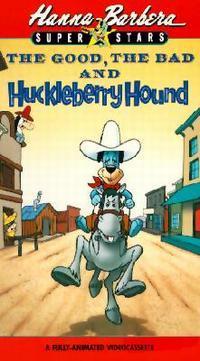 The Fall of 1987 saw the launch of “Hanna-Barbera’s Superstars 10.” This was a new series of made-for-TV features starring their classic characters. Huck was co-star in several including YOGI’S GREAT ESCAPE (1987) and YOGI AND THE MAGICAL FLIGHT OF THE SPRUCE GOOSE (1987).
The Fall of 1987 saw the launch of “Hanna-Barbera’s Superstars 10.” This was a new series of made-for-TV features starring their classic characters. Huck was co-star in several including YOGI’S GREAT ESCAPE (1987) and YOGI AND THE MAGICAL FLIGHT OF THE SPRUCE GOOSE (1987).
However, Huck did finally get the title role in THE GOOD THE BAD AND THE HUCKLEBERRY (1987). Aided by Yogi Bear, Magilla Gorilla, Quick Draw McGraw and other H-B characters, Huck takes the sheriff’s job in the old West town of Two-Bit.
Huck remained pretty much inactive until 1990 when he was cast in the “Fender Bender 500,” part of the daily syndicated series WAKE, RATTLE & ROLL. The segment featured numerous classic Hanna-Barbera characters (Yogi Bear, Snagglepuss, Top Cat, Magilla Gorilla, etc.) in 4×4 races around the world. In 1991, he appeared as a young teenager in Yo, Yogi!
Although he continued to appear in other projects including “guest cameos” on several series, Huckleberry Hound is the classic showbiz story of a top star who was upstaged by one of his supporting players. However, many of us are still fans of the character and hope he may return someday in a starring role worthy of him.


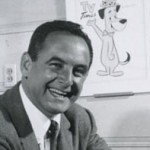
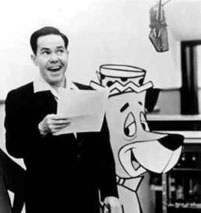
 Jim Korkis is an internationally respected animation historian who in recent years has devoted his attention to the many worlds of Disney. He was a columnist for a variety of animation magazines. With his former writing partner, John Cawley, he authored several animation related books including The Encyclopedia of Cartoon Superstars, How to Create Animation, Cartoon Confidential and Get Animated’s Animation Art Buyer’s Guide. He taught animation classes at the Disney Institute in Florida as well as instructing classes on acting and animation history for Disney Feature Animation: Florida.
Jim Korkis is an internationally respected animation historian who in recent years has devoted his attention to the many worlds of Disney. He was a columnist for a variety of animation magazines. With his former writing partner, John Cawley, he authored several animation related books including The Encyclopedia of Cartoon Superstars, How to Create Animation, Cartoon Confidential and Get Animated’s Animation Art Buyer’s Guide. He taught animation classes at the Disney Institute in Florida as well as instructing classes on acting and animation history for Disney Feature Animation: Florida.




















































I’ll tell you what happened to Huckleberry Hound: “Yo, Yogi!” happened. That show killed off the entire Hanna-Barbera funny animal franchise for the next quarter century. Even “Yogi’s Treasure Hunt” contained some vestiges of Huck’s former glory days, for example the amusing “Super Huck” segment.
Joe Barbera’s “planned animation” is a ridiculous term. All animation is planned; there’s no such thing as “unplanned animation”. Cartoons don’t just happen by accident or form naturally by crystallisation. “Limited animation” describes exactly what it is, and there’s no shame in saying so. All artists impose limits upon themselves with everything they do, and clearly defined limits can open up creative possibilities within those boundaries; it’s just part of the creative decision-making process. Besides, the animation is only one aspect of a cartoon. We all can think of examples of very entertaining limited-animation cartoons, and dreadfully dull fully animated ones.
As for the prospect of a Huckleberry Hound revival, I don’t know. I realise that Huck is the intellectual property of a media conglomerate that would love to extract a profit from him, or at least keep him from falling into the public domain so that no one else can. Whether such a reboot would result in a cartoon worth watching is by no means guaranteed; this is how travesties like “Yo, Yogi” come into being. Some cartoon characters, like Betty Boop and Bullwinkle, belong to a particular time in history; others, like Donald Duck and Scooby-Doo, are eternal. Given Huck’s sheer versatility — his ability to assume any role in any setting — our modern world could provide him with any number of possible stories. He could be a video blogger, a social media influencer, a reality show contestant; he could be annoyed by a drone flying over his backyard, or get taken in by the spam messages on his phone. We could use a likeable, laconic character who never gives up, and who takes every setback in stride, in this day and age.
But please don’t let him run for president again!
Great ideas!
i am dieing to see the original series in syndication, but I assume that will never happen, as most of the cartoons were satires of contemporary (i e 1958) TV series, unfamiliar to anyone younger than me. But I remember them, and they were brilliant.
Huck for President? He’d get my vote.
While appreciating the appeal of much of the character design and voice work, I never understood the entertainment value of virtually any of HB’s television output for anyone over the age of 10, unless based purely on nostalgia. Would any contemporary 25 year old go out of his way to see a Huckleberry Hound or even a Yogi Bear cartoon? Could you imagine actual laughter being generated in a movie theater by any of these? Has anyone sitting at home ever found himself laughing out loud at the Flintstones? I don’t fault the creators, of course. They were operating under severe limitations. But to regard the end product as anything other than kiddie fodder, I just don’t get it. I always seemed to me tragic that talents like Warren Foster, Daws Butler and Mel Blanc, not to mention HB themselves, were reduced to having nothing better to apply their considerable gifts to.
I found the Flintstones quite good. I think you got HB mixed up with Filmation.
Agreed..:) also to Rick, the Ranger’s last name was Smith (counterparts would include Mr.Twiddle for Wally Gator, Mr.Peebles for Magilla Gorilla, Chief Winchley for Squiddley Diddley, Mr.Peevely & Botch (OO! OO!) for Help! It’s the Hair Bear Bunch at Hanna-Barbera and Stanley Livingston for Tennesee Tuxedo and Chumley for Total TeleVision/Gamma.
Don’t forgot Ed Justin, COlumbia/Screen Gems/HB’s great merch man!
Stephen JC
Setting aside “The Flintstones,” it’s well documented in 1958 and 1959 there were Huck clubs on college campuses. The Huck show was on TV sets in bars; one had a sign about not making noise while the Huck show was on the air. A number of newspaper stories told of how the show attracted adult viewers, as Jim Korkis points out in this nice little summary.
So, no, the show didn’t only have10 year olds watching.
Not all the Hucks were great. There are some that I decidedly don’t like for a variety of reasons, and some that are disappointing, but there are others that are still enjoyable. I won’t comment about later series that included him.
Hanna and Barbera can thank Tex Avery for inventing the laid-back Southern wolf at MGM so they could steal the idea and re-work it with the help of Dan Gordon.
Whenever I read or hear someone disparaging Hanna-Barbera, I think if it was not for Bill Hanna, we would not have this.https://youtu.be/WDX_PZLOVsQ
“Has anyone sitting at home ever found himself laughing out loud at the Flintstones?”
I have.
For all their limitations, there weren’t many cartoons afterwards that properly used writers with golden age chops like Mike Maltese and Warren Foster or aesthetics as finely tuned as Ed Benedict’s character designs. I can imagine a cinema audience laughing at them. Perhaps these days you’d need “the right audience”, but still.
I assume the old HB cartoons are product of their time. Heck, alot of the live action sitcoms from that time are pretty boring today too.
For myself, aside from still enjoying the Simpsons and South Park- the second incarnation of DC Superhero Girls is the funniest cartoon to me these days.
I used to LOVE Huckleberry Hound as a little kid and had a Huckleberry Hound sandbag toss toy. I think what eventually eroded his popularity was the lack of a sidekick, and any built in conflict. Yogi Bear had Boo Boo and run ins with Ranger Stewert as he was always trying to steal picnic baskets. Quick Draw McGraw also had a sidekick and was much more of an action character as he was always fighting and catching outlaws. Huck just couldn’t keep the viewers attention with his slow talking, country charm. The entire franchise went down the tubes putting them altogether on an ark, and other dimwitted ideas. But for those of us who remember when Huck first popped up on our TV screens, there will always be a place in our hearts as one of our very first cartoon friends.
I thought the second “ark” show (Yogi’s Treasure Hunt”) was quite good. It helps that they had writers that grew up with him working on the show.
The problem with all these crossover shows, even the good ones, is that the HB funny animal characters are too similar to each other to work as a group
Thank God for fanfiction to disprove the notion … heck, on a Hanna-Barbera tribute blog I run on Tumblr, there’s plenty of instances where I’ve imagined interaction across the board with other characters from the H-B pantheon!
Especially where I set a story arc in the context of some interesting festival somewhere in the country (including the likes of the Truth or Consequences [NM] Fiesta, the Moxie Festival in Lisbon, ME and Mardi Gras in Mobile, AL) having potential for imagined meet-and-greets with visitors; such I call “Character Convocations.”
Equally interesting is where I’ve imagined recasting Peter Potamus and a few other mid-1960’s Hanna-Barbera characters as a most unlikely troupe of SCUBA divers whose ideal is to show the social-bonding potential of diving.
Need I say more?
Whenever I see Huckleberry Hound’s name on a ballot, he always gets my vote!
“HUCKLEBERRY HOUND” is my favorite cartoon character of all time!! He premiered on TV 2 days before l was born. He, Oct. 2, 1958….Me, Oct. 4, 1958. He will always be my absolute favorite cartoon character of ALL TIME!! I didn’t care too much for Yogi, at all. I hated the constant rhymes all the time. I loved Huck’s southern drawl!! Huck is the man!! The theme song was really catchy and great!!
As Huck aired in Los Angeles on September 30, 1958, it would be difficult for him to be born two days later.
This shows you what happens when incorrect information is put on the internet. It’s almost impossible to fix.
Huck’s first shows debuted in a number of cities, including Battle Creek, Michigan, the home of Kellogg, on Monday, September 29. The Leo Burnett agency booked time in an early evening hour whenever a station had it available. Thus it aired on Tuesdays in Los Angeles, Wednesdays in Chicago and Thursdays in New York.
The bogus “birthday” stems from a careless list put out by Turner after it acquired Hanna-Barbera.
Now he’s mayor of Jellystone. The city now, the country next!
My all time favorite Huckleberry Hound cartoon was Spud Dud, featuring the Giant potato.
Jim, in addition to Mickey, Mr.Magoo and Porky Pig (who was a Mickey Mouse type) were used in thsoe different guises…
Spoilers ahead.
Huck appears in DC Comics’ “realistic” Exit Stage Left: The Snagglepuss Chronicles. He plays the gay lover of Quick Draw McGraw; when outed, he commits suicide.
The whole thing same without notice, which is odd when you consider all the fans who went ballistic when it was suggested the Rawhide Kid was gay.
Huckleberry Hound was destined to last only as long as the great Daws Butler did; he gave Huck life in a way no “planned animator” ever could. You probably could find a voice actor who could do a decent recreation, but it wouldn’t be the same.
The real problem with “Yogis Ark Lark” was the same as those 1970s Bugs Bunny TV specials. Xerography made classic characters of the “ink” era look old and frayed.
By the time Huckleberry Hound showed up I was 12 or 13 and had 6 or 7 years of TV cartoon viewing under my belt, the vast majority what even then had been vintage theatricals. I had big portions of Popeyes, Looney Tunes and Merrie Melodies memorized. Huckleberry Hound struck me as boring, dumb and static. Which might sound odd since early on I’d been a big Crusader Rabbit fan, and you can’t get much more static than that. I’d even watched Ruff and Reddy with some interest. I eventually warmed a bit to some H-B productions – Quick Draw McGraw I thought was funny, and later watched the first couple seasons of The Flintstones. But the only TV cartoon production I really went gaga over was Rocky and Bullwinkle.
Anyone have any theories as to why Scooby outlasted every single other HB cartoon?
Cartoon Network programming execs force feeding viewers, still being played where most were shafted to Boomerang and/or very little airtime on the channel (I recalled it won some “Best Cartoon” poll around 20 years ago over Bugs Bunny and then current characters) and also direct to DVD movies and live action film from the late 1990s/early 2000s gained popularity while most of other properties were either ignored or have flopped (ie “Real Adventures of Johnny Quest”, “Flintstones on the Rocks”, infamous Yogi Bear shorts)
I once read YouTube comments on a Spider-Man 67 video and some of the younger people were like “wow this is just like Scooby”. It’s funny how that show now represents an entire decade of animation to people who have not seen anything else
Bill Hanna once confided in me, “Don’t create anything if you can steal it.”
I think that Huck was more than a steal of Tex Avery’s wolf performance by Daws. His premiere was aligned with the popularity of another mild-mannered TV character that was often the little guy who won in the end — George Gobel.
Huckleberry Hound, the show, quickly got me hooked as a 7-year-old, and my parents liked it too. My Dad even wanted to film a cartoon off the screen, kinescope-style (didn’t happen). It really was a different kind of cartoon show, and if you watch any of the earlier Ruff and Reddy episodes, which are strictly kid stuff, you can spot the advance in the quality of the writing, and what sort of audience they were going for.
I liked Huck, and his slipping into different roles (Scrubby Brush salesman, Old West lawman, champion bowler (versus Powerful Pierre) and even a London bobby, out to get the Picadilly Dilly (how did he land that job?), were always a fun surprise.
I liked Yogi too. Pixie and Dixie, less so. I guess the audience responded to Yogi’s conniving, and Boo Boo’s wet-blanket asides (“The Ranger isn’t gonna like it!”) – funny, but comfortably predictable, more readily than Huck’s shifting personae (but of course, he was always Huck).
But Hanna Barbera sure burned out fast as innovators. Quick Draw McGraw had some of the old spark, but co-features Augie Doggie and Snooper and Blabber really only had trick voices to recommend them. When Yogi got his own show his cohorts were even worse. It’s around this time that every new Hanna Barbera character was shown smiling all the time (except for Hardy Har Har), but there was no inspiration visually or otherwise. It was all just one-joke premises run into the ground.
But I think the original Huck cartoons stand up today, if you gear yourself to see worn-out slapstick gags reduced to the bare essence, like a hand holding a big wrench coming down on a burglar’s noggin – three drawings, maximum! – more conceptual than actual humor, and often followed up by a deadpan remark from Huck or some bit player.
The term planned animation is simply a euphemism for limited (or “restricted”) animation.
Thanks for not mentioning the Huck appearing in HBO Max’s absolutely hideous massacre of H-B IP. And it was actually YOGI’s GANG, not YOGI’s ARK.
Huck’s voice is virtually indistinguishable from Reddy’s (of RUFF AND…), as was made obvious to me when I got the Colpix RUFF & REDDY and HUCKLEBERRY HOUND LPs on the same day back in 1959, so it’sobvious that the character was built around the voice and demeanor unique to Daws Butler. The latterday Huck appearance on those mass-character shows suffered both from Daws’ age at the time and the obvious lack of his input in his dialogue, which was always considerable in the original series he voiced, (apart from the awful Iwao Takamoto character design and the xerography which made the animation look far cheaper than the thick-lined inked cells from decades previous. (By the way, CASPER’S FIRST CHRISTMAS predated YOGI’S FIRST CHRISTMAS by exactly a year and featured H-B’s regular band of Butler-voiced guest-stsrs: Huck, Yogi, Quick Draw, Augie, Snagglepuss and Don Messick’s Boo Boo. (YOGI’S FIRST CHRISTMAS “replaced” Quick Draw with Diggie Daddy and Cindy Bear.) Just as the participants in these specials were determined by who voiced them originally, once Daws died, so did his characters, for the most part. Since then, if you want to resurrect the originaly (and obviously the best) H-B characters from their first decade, you have to go through the same recasting process Warner’s done for Mel Blanc’s voice ouvre, hoping that the actors chosen aren’t hired because of their live-action notoreity, AND are able to emulate not only the voice, but Butler’s unique and inimitable delivery over the entirety of the cartoon.
I’m of the opinion that those animal characters being desecrated by that unmentionable HBO Max series could easily be re-created in the Dick Bickenbach/Ed Benedict/ Jerry Eisenberg style but polished up to the more fully animated contemporary levels by the dozens of ultra-talented animators of today, and stories created in the original Shows/Malese/Foster spirit of those classic series wouldn’t be terribly difficult–but finding adequate replacements for Butler, Messick, Doug Young, Bill Thompson, Arnold Stang, Allan Melvin, Mel Blanc, Paul Frees and Howard Morris is the biggest problem. Perhaps we will need to wait for the AI voice replication software technology which has been successfully used to recreate missing phrases or sentences in old recordings is up to recreating full performances for these hypothetical future cartoons. In other words, for Huck’s star to rise again, the firmament will need to align more perfectly than it ever has in the past.